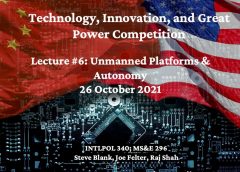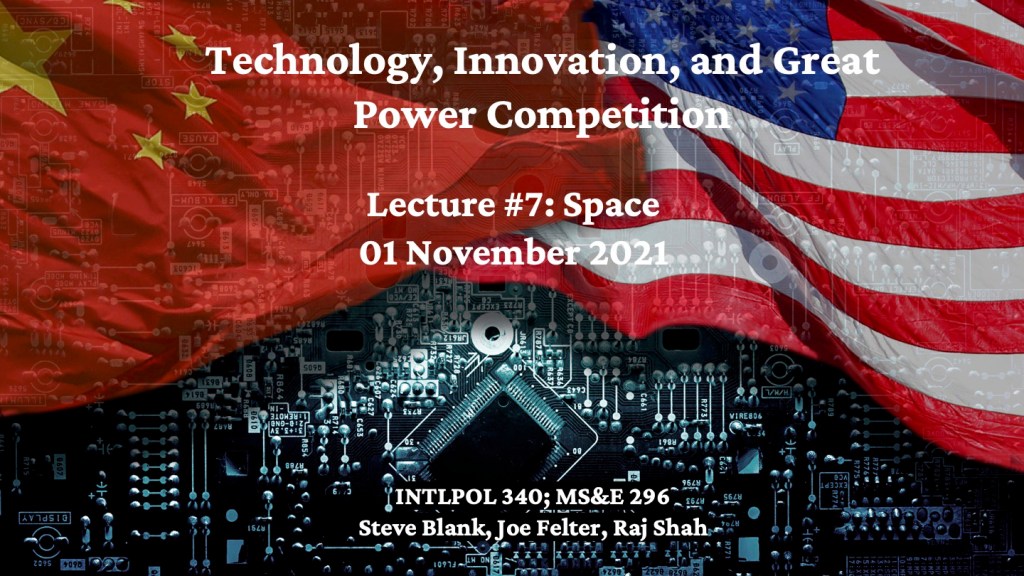
Steve Blank Technology, Innovation, and Great Power Competition – Class 6 – Unmanned Systems and Autonomy
[ad_1]
![]() This article first appeared in West Point’s Modern War Institute.
This article first appeared in West Point’s Modern War Institute.
We just completed the sixth week of our new national security class at Stanford – Technology, Innovation and Great Power Competition. Joe Felter, Raj Shah and I designed the class to cover how technology will shape the character and employment of all instruments of national power.
In class 1, we learned that national power is the sum of all the resources available to a state to pursue its national objectives and interests. This power is wielded through a combination of a country’s diplomacy, information, its military capabilities, economic strength, finance, intelligence, and law enforcement. These instruments of national power employed in a “whole of government approach” to advance a state’s interests are known by the acronym DIME-FIL.
Class 2 focused on China, the U.S.’s primary great power competitor. China is using all elements of its national power, e.g. information/ intelligence, its military might and economic strength as well as exploiting Western finance and technology. China’s goal is to challenge and overturn the U.S.-led liberal international order and replace it with its own neo-totalitarian model where China emerges as the dominant regional and global power.
The third class focused on Russia, which since 2014 has asserted itself as a competing great power. We learned how Russia pursues security and economic interests in parallel with its ideological aims.
The fourth class shifted our focus to the impact commercial technologies have on the instruments of national power (DIME-FIL). The first technology we examined were semiconductors, and the U.S. dependence on TSMC in Taiwan, for its most advanced logic chips. This is problematic as China claims Taiwan is a province of China.
In the fifth class we examined the impact that AI and Machine Learning will continue to have on the capabilities and employment of DIME-FIL. We heard from the Joint Artificial Intelligence Center (JAIC), the focal point of the DOD AI strategy; and from the Defense Innovation Unit (DIU) – a DoD organization that contracts with commercial companies to solve national security problems.
Today’s class: Unmanned Platforms and Autonomy
Catch up with the class by reading our intro to the class, and summaries of Classes 1, 2, 3, 4 and 5

Required Readings
Unmanned Aerial Vehicles (UAV) & Unmanned Aerial Systems (UAS)
- Helen Warrell, “From Desert Storm to Soleimani: How US Drone Warfare has Evolved” Financial Times2020.
- Kelley Sayler, “A World of Proliferated Drones: A Technology Primer” Center for a New American Security2015.
- Paul Scharre et al., “Why Drones Are Still the Future of War: Troops Will Learn to Trust Them” Foreign Affairs2018.
- Erik Lin-Greenberg, “Game of Drones: What Experimental Wargames Reveal About Drones and Escalation” War on the Rocks2019.
- David Hambling, “What Are Drone Swarms and Why Does Every Military Suddenly Want One?” Forbes2021.
- VIDEO “Slaughterbots” Stop Autonomous Weapons – YouTube2017.
Unmanned Surface Vessel (USV) / Unmanned Undersea Vessel (UUV)
U.S. Unmanned Warfare Concepts
China Unmanned Warfare Concepts
Use of Drones in Nagorno-Karabakh
Reading Assignment Questions
Pick one of the below questions and answer in approximately 100 words, based on the required readings.
- Describe how the advent of autonomous weapon systems (i.e. drones) has changed the American way of war to date. What changes would you recommend America adopt as autonomous systems continue to develop?
- Pick one domain of war (e.g. air, land, sea, subsea, space, etc.). How does the proliferation of autonomous weapon systems to great powers, lesser powers, or non-state actors (pick one of the three) threaten America’s traditional military advantages in that domain?
Class 6 – Guest Speakers and Autonomy Panel
This class had seven guest speakers on unmanned systems and autonomy.
Our first guest speaker was Rear Admiral Lorin Selby, Chief of Naval Research, United States Navy. Admiral Selby is responsible for the Naval Research Enterprise. It is the “venture capital” of the Navy and Marine Corps. It’s made up of ONR – the Office of Naval Research, ONR Global, the Naval Research Laboratory, and Special Projects (PMR 51.)
(Founded in August 1946, ONR provided support of research at universities when WWII government funding to universities had dried up. Fred Terman, Stanford’s dean of engineering, received ONR’s first research grants for electronics and microwaves. These grants funded the Stanford Electronics Research Laboratory and kick-started innovation in what would become Silicon Valley.) Fast forward to this decade and ONR funded our first Stanford Hacking for Defense classes and is the first funder of the Stanford Gordian Knot Center for National Security Innovation.
RADM Selby described the role of the Chief of Naval Research, the types of innovation, the role of ONR in capturing new/relevant ideas and pulling them in fast enough to compete with adversaries, but not disrupt the functionality of the Navy.
Our next guest was Maynard Holliday the DoD Director of Defense Research and Engineering for Modernization (5G; Artificial Intelligence and Machine Learning; Autonomy; Biotechnology; Cyber; Directed Energy; Fully Networked Command, Control, and Communications; Hypersonics; Microelectronics; Quantum Science; and Space). He described the role of his office as similar to DARPA. His 11 principal directors lay out the technical roadmaps for the DoD and help transition the technologies into operational use.
The principal DoD Modernization director for autonomy, Dr. Jaret C. Riddick, then joined us. He helped the class understand the DoD definition of Autonomy, the Lines of Effort the DoD is actively pursuing, and why it was important.
Lecture 6
If you can’t see the lecture 6 slides click here.
In the Department of Defense unmanned systems and autonomy are moving ahead rapidly. We gave the students a feel for the scope of the activities in two panel sessions.
Panel 1 – Autonomy/Unmanned Systems Research and Engineering
RADM Selby, Mr. Holliday, and Mr. Riddick joined a panel discussion on how their organizations set their research priorities and investment strategies. They discussed:
- What time horizon their organizations consider when determining which technologies to invest in
- How these investment strategies and time horizons compare and contrast with the same considerations made by China and Russia
- What the future of autonomous systems looks like. What the largest gains their organizations hope to make with investments in autonomy
- What ethical considerations they take into account when making technology investments Whether China and/or Russia have similar or different ethical considerations. How these ethical frameworks affect America’s ability to compete
Panel 2 – An Application of Autonomy – the Navy Unmanned Task Force
Four other experts on Autonomy in defense joined us for a discussion of the Vice Chief of Naval Operations Unmanned Task Force: Michael Stewart, Director of the US Navy Unmanned Task Force and Deputy Director Integrated Warfare; Bradley Garber, Deputy Director/Principal Civilian Advisor to the Vice Chief of Naval Operations; Dr. Jason Stack, the Office of Naval Research Portfolio Manager for Autonomy; and Dr. Shane Arnott, Chief Engineer, Anduril Industries. They discussed:
- The impetus for the creation of their task forces
- The biggest challenges and opportunities for integrating autonomy from the private sector to support the DoD
- What the future of autonomous systems looks like. The largest gains that their organizations hope to make with investments in autonomy
- Where China and/or Russia are making the largest gains with autonomous systems. What threat this presents to U.S. interests
Next Week: The Second Space Age: Great Power Competition in Space
Lessons Learned
- Autonomy and Unmanned Systems are critical technologies that will impact all aspects of the instruments of DIME-FIL national power
- While advanced work in autonomy is happening in the DoD ecosystem, commercial companies and universities still lead
- China and Russia have made autonomy and unmanned systems national priorities
- Other countries, e.g. Turkey and Israel, have proliferated systems that have been used to win a war
- The Navy is actively looking to build and integrate unmanned/autonomous systems as part of the fleet

Filed under: Technology Innovation and Great Power Competition |
[ad_2]
Source link


